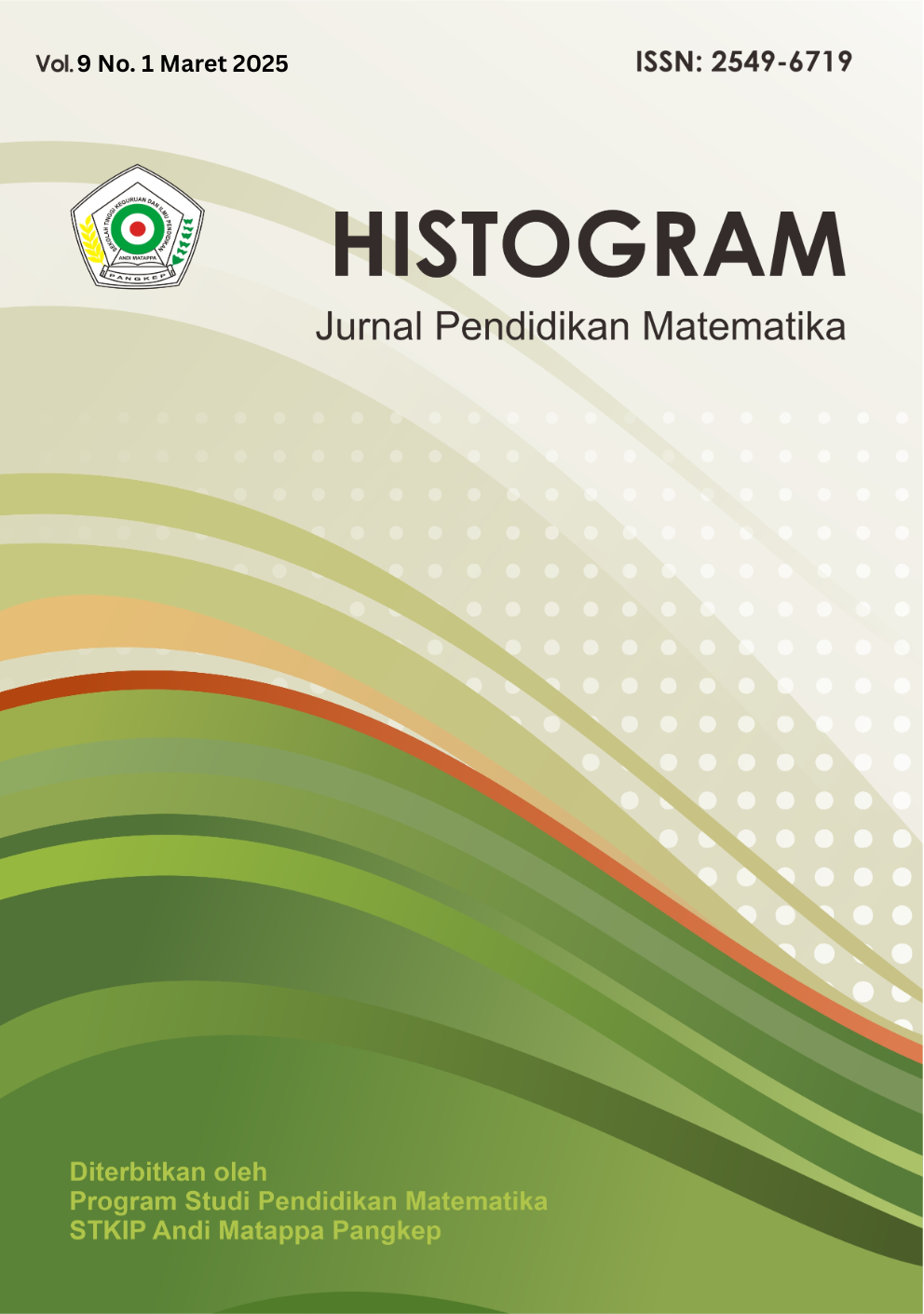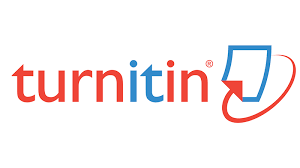PEMECAHAN MASALAH MATEMATIKA SMP BERBASIS SOAL HOTS: ANALISIS BERPIKIR TINGKAT TINGGI
DOI:
https://doi.org/10.31100/histogram.v9i1.4198Keywords:
Berpikir Tingkat Tinggi, Pemecahan Masalah, Soal HOTSAbstract
ABSTRAK
Penelitian ini bertujuan untuk menganalisis kemampuan berpikir tingkat tinggi peserta didik jenjang SMP dalam menyelesaikan soal matematika berbasis Higher Order Thinking Skills (HOTS) ditinjau dari tahapan pemecahan masalah. Penelitian ini penting karena keterampilan berpikir tingkat tinggi merupakan bekal esensial bagi peserta didik dalam menghadapi tantangan abad ke-21. Kemampuan dalam menganalisis, mengevaluasi, dan mencipta merupakan bagian dari kompetensi utama yang perlu dikuasai dalam pembelajaran matematika. Pendekatan penelitian yang digunakan adalah kualitatif dengan metode deskriptif. Subjek penelitian terdiri atas tiga peserta didik kelas VIII dari salah satu SMP swasta di Gresik yang dipilih berdasarkan kategori kemampuan tinggi, sedang, dan rendah. Instrumen penelitian mencakup soal tes berbasis HOTS dan pedoman wawancara. Temuan penelitian menunjukkan bahwa: 1) peserta didik dengan kemampuan tinggi berhasil memenuhi seluruh indikator berpikir tingkat tinggi, yakni menganalisis, mengevaluasi, dan mencipta, 2) peserta didik dengan kemampuan sedang hanya menunjukkan kemampuan pada aspek menganalisis, dan 3) peserta didik dengan kemampuan rendah belum mampu melampaui tahap menganalisis.
ABSTRACT
This study aims to analyze junior high school students’ higher-order thinking skills (HOTS) in solving mathematics problems based on problem-solving stages. The urgency of this research lies in the essential role of higher-order thinking skills as a key competence for students to face 21st-century challenges. The abilities to analyze, evaluate, and create are core components in mathematics learning. This research employed a qualitative approach with a descriptive method. The participants consisted of three eighth-grade students from a private junior high school in Gresik, selected based on their ability level: high, moderate, and low. Research instruments included HOTS-based test items and interview guidelines. The results indicate that: 1) high-ability students were able to meet all higher-order thinking indicators, namely analyzing, evaluating, and creating, 2) moderate-ability students demonstrated skills only in analyzing, and 3) low-ability students had not progressed beyond the analyzing stage.
References
Cresswell, J. W., & Poth, C. N. (2018). Qualitative Inquiry & Research Design: Choosing Among Five Approaches (Fourth edi). SAGE.
Dwiyana, S., Surahmat, & Anies Fuady. (2021). Analisis Kemampuan Pemecahan Masalah Matematika dalam Menyelesaikan Soal (HOTS) High Ortder Thinking Skill ditinjau dari Minat Belajar pada Materi Himpunan Kelas VII SMP Badridduja Full Day School. Jp3, 16(30), 41–54. https://jim.unisma.ac.id/index.php/jp3/article/view/14651
Faradiba, S. S., Fuady, A., & Sari, D. N. (2021). Pseudo Abstraksi Reflektif dalam Menyelesaikan Masalah Barisan Bilangan. HISTOGRAM: Jurnal Pendidikan Matematika, 4(2), 409–422. https://doi.org/10.31100/histogram.v4i2.685
Fikriani, T., & Nurva, M. S. (2020). Analisis Kemampuan Pemecahan Masalah Siswa SMP Kelas IX dalam Menyelesaikan Soal Matematika Tipe Higher Order Thinking Skill (HOTS). AKSIOMA: Jurnal Matematika dan Pendidikan Matematika, 11(2), 252–266. https://doi.org/10.26877/aks.v11i2.6132
Hasyim, M., & Andreina, F. K. (2019). Analisis High Order Thinking Skill (HOTS) Siswa dalam Menyelesaikan Soal Open Ended Matematika. FIBONACCI: Jurnal Pendidikan Matematika dan Matematika, 5(1), 55–64. https://doi.org/10.24853/fbc.5.1.55-64
Hurrell, D. (2021). Conceptual Knowledge or Procedural Knowledge or Conceptual Knowledge and Procedural Knowledge: Why the Conjunction is Important to Teachers. Australian Journal of Teacher Education. https://doi.org/https://doi.org/10.14221/AJTE.2021V46N2.4.
Ibrahim, H., Adelia, R. W., & Wandini, R. R. (2023). Analisis Kemampuan Pendekatan Terstruktur yang Mempengaruhi dalam Pemecahan Masalah Matematika. Jurnal Pendidikan Tambusai, 8, 1494–1499. https://doi.org/10.31004/jptam.v8i1.12599
Nafi’an, M. I., & Pradani, S. L. (2019). Analisis Kemampuan Pemecahan Masalah Siswa dalam Menyelesaikan Soal Matematika Tipe Higher Order Thinking Skill ( HOTS ). KREANO: Jurnal Matematika Kreatif-Inovatif, 10(2), 112–118. https://journal.unnes.ac.id/nju/kreano/ article/download/15050/9823
Putri, F., Marmoah, S., & Supianto, S. (2024). Analyzing Students Mathematical Problem Solving Skills Through HOTS-Based Questions at the Elementary School Level. Social, Humanities, and Educational Studies (SHES): Conference Series. https://doi.org/10.20961/shes.v7i1. 84280.
Ramadhanti, F. T., Juandi, D., & Jupri, A. (2022). Pengaruh Problem-Based Learning terhadap Kemampuan Berpikir Tingkat Tinggi Matematis Siswa. AKSIOMA: Jurnal Program Studi Pendidikan Matematika, 11(1), 667–682. http://doi.org/10.24127/ajpm.v11i1.4715
Riska, A., Gunur, B., Tamur, M., & Ramda, A. H. (2023). Pengaruh Model Pembelajaran Problem Solving Berbantuan Geogebra terhadap Kemampuan Pemecahan Masalah Matematika. AKSIOMA: Jurnal Matematika dan Pendidikan Matematika, 14(2), 221–229. http://doi.org/ 10.26877/aks.v14i2.16102
Rosyidah, A. S., Hidayanto, E., & Muksar, M. (2022). Kemampuan Penalaran Matematis Siswa SMP dalam Menyelesaikan Soal HOTS Geometri. JIPM (Jurnal Ilmiah Pendidikan Matematika), 10(2), 268–283. http://doi.org/10.25273/jipm.v10i2.8819
Santoso, T., Cholily, Y. M., & Syaifuddin, M. (2021). An Analysis of Students’ Errors in Completing Essay HOTS Questions Based on Watson’s Criteria Viewed from the Cognitive Style Perspective. JTAM (Jurnal Teori dan Aplikasi Matematika), 5(1), 121–133. https://doi.org/ 10.31764/jtam.v5i1.3776
Saputra, I., Septiawan, A., Stevano, N.Angraini, L., & Bonyah, E. (2025). Analysis of Students’ Mathematical Problem-solving Ability on Number Matter. International Journal of Contemporary Studies in Education (IJ-CSE). https://doi.org/10.56855/ijcse.v4i1.1045.
Saraswati, P. M. S., & Agustika, G. N. S. (2020). Kemampuan Berpikir Tingkat Tinggi dalam Menyelesaikan Soal HOTS Mata Pelajaran Matematika. Jurnal Ilmiah Sekolah Dasar, 4(2), 257–269. https://ejournal.undiksha.ac.id/index.php/JISD/article/download/25336/15392/46 075
Singh, C. K. S., & Marappan, P. (2020). A Review of Research on the Importance of Higher Order Thinking Skills (HOTS) in Teaching English Language. Journal of Critical Reviews, 7(8), 740–747. https://doi.org/10.31838/jcr.07.08.161
Wulandari, S. (2023). Kesulitan Belajar Siswa dalam Berpikir Tingkat Tinggi Berdasarkan Teori Newman. Journal Tunas Bangsa, 10(1), 48–59. https://doi.org/10.46244/tunasbangsa.v10 i1.2020
Yulianto, D., & Maryam, S. (2023). Analisis Kemampuan Berpikir Tingkat Tinggi (HOTS) Siswa Sekolah Dasar Negeri dalam Menyelesaikan Soal AKM : Studi Kasus di Kabupaten Lebak Banten. Prosiding Seminar Nasional Pendidikan Matematika V (Sandika V), 63–83.
Downloads
Published
Issue
Section
Citation Check
License
Copyright (c) 2025 Ruf’aniyah, Surya Sari Faradiba, Alifiani, Sikky El Walida, Abdul Halim Fathani, Isbadar Nursit

This work is licensed under a Creative Commons Attribution-NonCommercial-NoDerivatives 4.0 International License.
Please find the rights and licenses in Histogram: Jurnal Pendidikan Matematika. By submitting the article/manuscript, the author(s) accept this policy.
1. License
The non-commercial use of the article will be governed by the Creative Commons Attribution license as currently displayed on Creative Commons Attribution-ShareAlike 4.0 International.
2. Author's Warranties
The author warrants that the article is original, written by a stated author(s), has not been published before, contains no unlawful statements, does not infringe the rights of others, is subject to copyright that is vested exclusively in the author and free of any third party rights, and that any necessary written permissions to quote from other sources have been obtained by the author(s).
3. User Rights
Histogram: Jurnal Pendidikan Matematika's spirit is to disseminate articles published for free. Under the Creative Commons license, Histogram: Jurnal Pendidikan Matematika permits users to copy, distribute, display, and perform the work for non-commercial purposes only. Users will also need to attribute authors and Histogram: Jurnal Pendidikan Matematika when distributing works in the journal.
4. Rights of Authors
Authors retain all their rights to the published works, such as (but not limited to) the following rights;
- Copyright and other proprietary rights relating to the article, such as patent rights,
- The right to use the substance of the article in one's future works, including lectures and books,
- The right to reproduce the article for one's purposes,
- The right to self-archive the article,
- The right to enter into separate, additional contractual arrangements for the non-exclusive distribution of the article's published version (e.g., post it to an institutional repository or publish it in a book), with an acknowledgment of its initial publication in this journal (Histogram: Jurnal Pendidikan Matematika).
5. Co-Authorship
If other authors jointly prepared the article, any author submitting the manuscript warrants that all co-authors have authorized them to agree on this copyright and license notice (agreement) on their behalf and agree to inform their co-authors of the terms of this policy. Histogram: Jurnal Pendidikan Matematika will not be held liable for anything arising from the author(s) internal dispute. Histogram: Jurnal Pendidikan Matematika will only communicate with the corresponding author.
6. Royalties
This agreement entitles the author to no royalties or other fees. To such an extent that it is legally permissible, the author waives their right to collect royalties relative to the article regarding any use by Histogram: Jurnal Pendidikan Matematika.
7. Miscellaneous
Histogram: Jurnal Pendidikan Matematika will publish the article (or have it published) in the journal if the editorial process is completed. Histogram: Jurnal Pendidikan Matematika h editors may modify the article to a style of punctuation, spelling, capitalization, referencing, and usage that deems appropriate. The author acknowledges that the article may be published to be publicly accessible, and such access will be free of charge for the readers, as mentioned in point 3.





